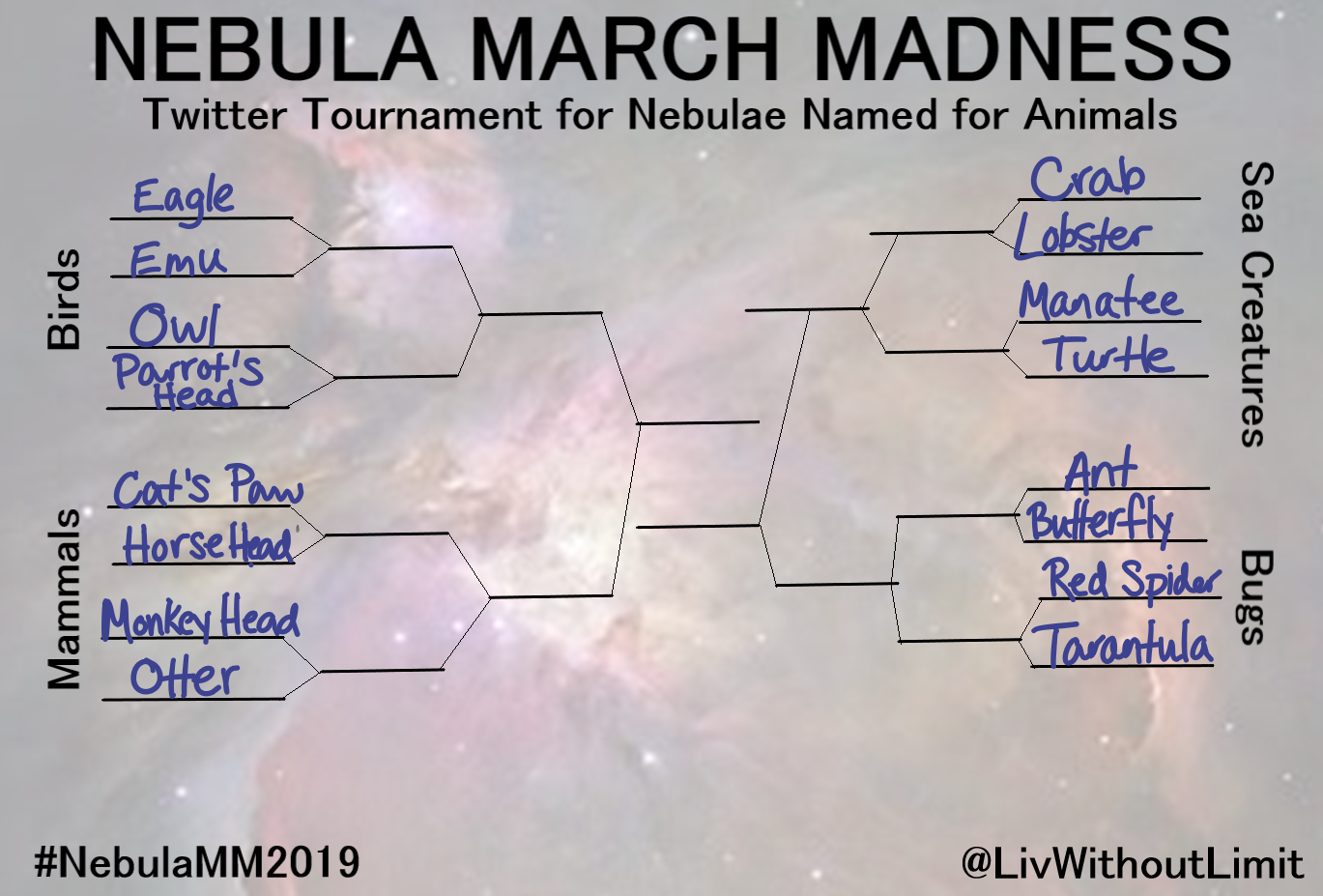Nebula March Madness 2019 - Round 1
Olivia Wilkins
It’s March (already!?), which means it is time for MARCH MADNESS!!! This isn’t just any March Madness bracket; this bracket is out-of-this-world (sorry). Each week during the month of March, I’m planning to share some information about different nebulae named for animals. Polls on Twitter will be used to decide which nebulae progress to the next round, during which I will share some new facts about the nebulae that move on. You can follow along on Twitter with the hashtag #NebulaMM2019.
What is a nebula?
A nebula is a cloud of gas and dust in outer space. Nebulae vary in size and composition and can have atomic, ionized, or even molecular gas. Some nebulae consist of molecular clouds which are sometimes affectionately called stellar nurseries (if they contain star-forming regions, that is!).
Nebulae are often named for what observers think they look like, and I've selected 16 nebulae that have been named for animals. I've divided these up into those named for birds, mammals, sea creatures, and bugs, and each week we will eliminate a handful of nebulae and learn a bit more about the rest.
ROUND 1: Physical Characteristics
This round focuses on some quick stats: broad physical characteristics like coordinates, distance, and radius.
BIRDS
Eagle Nebula vs. Emu Nebula
Eagle Nebula (Image: ESO)
Right ascension: 18h19m
Declination: -13°49’
Distance: 7,000 lightyears
Radius: ~70 x 55 lightyears
Constellation: Serpens
Emu Nebula (Image: A. Fujii) - complex including Coalsack Nebula
Right ascension: 12h50m
Declination: -62°30’
Distance: 600 lightyears
Radius: 30 - 35 lightyears
Constellation: Crux
Owl Nebula vs. Parrot’s Head Nebula
Owl Nebula (image: K. Quattrocchi)
Right ascension: 11h14m
Declination: +55°01’
Distance: 2,000 lightyears
Radius: 0.9 lightyears
Constellation: Ursa Major
Parrot’s Head Nebula or Seagull Nebula (Image: M. Sidonio)
Right ascension: 07h04m
Declination: -10°27’
Distance: 3,650 lightyears
Radius: 50 lightyears
Constellation: Monoceros
MAMMALS
Cat’s Paw Nebula vs. Horse Head Nebula
Cat’s Paw Nebula (Image: ESO)
Right ascension: 17h19m
Declination: -35°58’
Distance: 5,500 lightyears
Radius: 40 lightyears
Constellation: Scorpius
Horsehead Nebula (Image: K. Crawford)
Right ascension: 05h41m
Declination: -02°27’
Distance: 1,500 lightyears
Radius: 3.5 lightyears
Constellation: Orion
Monkey Head Nebula vs. Otter Nebula
Monkey Head Nebula (Image: S. Hamel)
Right ascension: 06h10m
Declination: +20°30’
Distance: 6,400 lightyears
Constellation: Orion
Otter Nebula (unofficial name for NGC 604, courtesy of @bispectral/@letstessallate on Twitter; Image: Hubble)
Right ascension: 01h35m
Declination: +30°47’
Distance: 2,700,000 lightyears
Radius: 760 lightyears
Constellation: Triangulum
SEA CREATURES
Crab Nebula vs. Lobster Nebula
Crab Nebula (Image: NASA/ESA)
Right ascension: 05h35m
Declination: +22°01’
Distance: 6,500 lightyears
Radius: 5.5 lightyears
Constellation: Taurus
Lobster Nebula (Image: J. Jennings)
Right ascension: 17h24m
Declination: -34°20’
Distance: 8,000 lightyears
Constellation: Scorpius
Manatee Nebula vs. Turtle Nebula
Manatee Nebula (Image: NRAO/AUI/NSF, K. Golap, M. Goss; NASA’s Wide Field Survey)
Right ascension: 19h12m
Declination: +04°59’
Distance: 18,000 lightyears
Constellation: Aquila
Turtle Nebula (Image: J. Poepsel and S. Binnewies)
Right ascension: 16h44m
Declination: +23°48’
Distance: 6,500 lightyears
Constellation: Hercules
BUGS
Ant Nebula vs. Butterfly Nebula
Ant Nebula (Image: NASA/ESA)
Right ascension: 16h17m
Declination: -51°59’
Distance: 8,000 lightyears
Radius: 1 lightyear
Constellation: Norma
Butterfly Nebula (Image: NASA/ESA)
Right ascension: 17h14m
Declination: -37°06’
Distance: 3,400 lightyears
Radius: >1.5 lightyears
Constellation: Scorpius
Red Spider Nebula vs. Tarantula Nebula
Red Spider Nebula (Image: ESO)
Right ascension: 18h05m
Declination: -19°51’
Distance: 5,000 lightyears
Radius: 1.1 lightyear
Constellation: Sagittarius
Tarantula Nebula (Image: TRAPPIST/E. Jehin/ESO)
Right ascension: 05h39m
Declination: -69°06’
Distance: 160,000 lightyears
Radius: 930 lightyears
Constellation: Dorado
Which nebulae are your picks? Share in the comments, and don't forget to follow along on Twitter!

